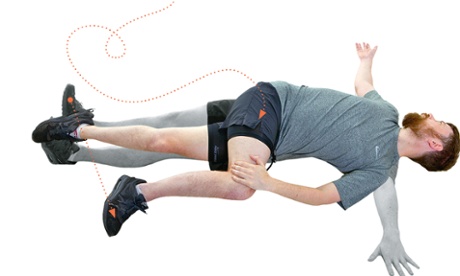
Do the twist
After a night in bed, the muscles in your lower back can be tight. “This spinal twist will loosen up the lower back and the deep breathing will gently wake you up,” says personal trainer Mollie Millington.
Lie on your back with legs straight and arms stretched out to the side. Swing your right leg over your left leg, twisting at the hip, and let the right leg lie at a 90˚ angle. Ensure that your shoulders remain on the floor (or bed, if you’re still in it).
Turn your head to look in the opposite direction to the bent leg. Take two to four deep breaths with a conscious effort to relax on the exhale. Repeat on the other side.
Thread the needle
This adaptation of the traditional child’s pose really helps stretch out any tension in the neck and shoulders “which is another classic area of tightness in the morning” says Millington.
Go into child’s pose – sitting on your haunches, bottom touching heels, head on the floor (or as close as you can get it) and arms outstretched in front of you. Keep your knees far enough apart to be comfortable. Take your right arm and slide it underneath your left armpit, then extend it with your palm facing upwards. Turn your head to look at your palm. Hold for 10 seconds, taking deep breaths and repeat on the other side.
Hang low
A great move for stretching out the lower back and hamstrings. “Raising your arms above your head will also gently increase heart rate to wake you up and help you feel more alert,” says Millington.
Stand with your feet together, knees slightly bent and hands in prayer position in front of your chest. Keeping your palms together, inhale and raise your hands above your head and follow them with your gaze. Once your arms are extended, exhale, separate your hands and roll down towards your toes with straight arms, bending at the waist.
When you’re down, let your head hang, put your hands on opposite elbows and sway gently from side to side to side, taking two long, deep breaths. Slowly stand upright to avoid a head rush. Repeat three to five times.
Grab a broom
Millington recommends this move to clients who have inflexible shoulders and poor posture. “It increases shoulder flexibility, opens up the chest for deep, energising breaths and improves posture ready for a day spent at a desk,” she says.
Hold a stick out in front of with hands wider than your shoulders (you can use an exercise band or scarf if your shoulders are inflexible). Inhaling as you lift, raise the stick up over your head and down behind you – the aim is to touch your bottom but just go as far as is comfortable.
Your elbows should remain straight throughout – if you can’t manage this, widen your grip and try again. Exhale, and as you inhale, lift the stick back over your head to the starting position. Repeat four to five times.
Be a cobra
“This yoga stretch is one of the most invigorating and really opens up the chest, encouraging deep breaths,” says Millington. It also boosts your circulation and strengthens your back and stomach.
Lie on your stomach with your toes flat on the floor and forehead resting on the ground. Place your palms on the ground beneath under your shoulders and keep your elbows parallel and close to your body.
Inhale and slowly lift your head, chest and abdomen but keep your pubic bone on the floor. Keep a slight bend in the elbows and be careful not to overextend your back.
Tilt your head back and look up, keeping your shoulders away from your ears. As you exhale, lower back down. Rest and repeat four to five times.
You can adapt this pose by keeping your forearms on the floor and raising only your head and chest (sphinx pose).
If you have a health condition or injury, consult your doctor before performing these moves. For more tips from Mollie Millington, visit ptmollie.com

